Tuesday 18 April, 2006, 15:31
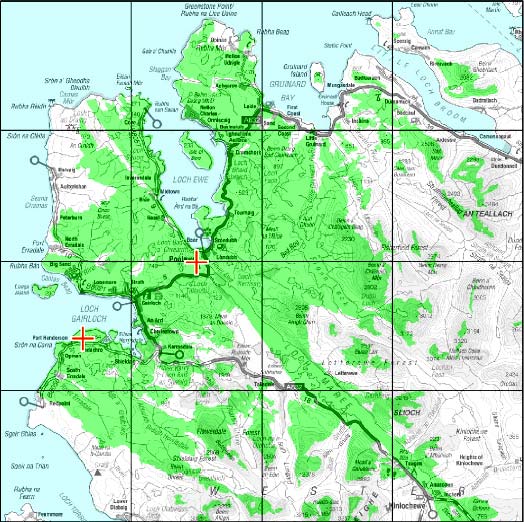 The number of radio stations in the UK has been on the increase since commercial radio was first licensed since the late 1970's. The latest raft of licences (excluding the community licences recently awarded) includes stations whose potential audience is, to put it mildly, tiny. The coverage of stations such as TwoLochs FM, LochBroom FM and Isles FM - all of which are in a highly unpopulated area of Northern Scotland - probably does not stretch to more than around 10,000 people. There is an unarguable need for these isolated communities to have local services to bring them together and broadcast radio is a good way of doing this, however one has to wonder whether it is a good use of the radio spectrum or not.
The number of radio stations in the UK has been on the increase since commercial radio was first licensed since the late 1970's. The latest raft of licences (excluding the community licences recently awarded) includes stations whose potential audience is, to put it mildly, tiny. The coverage of stations such as TwoLochs FM, LochBroom FM and Isles FM - all of which are in a highly unpopulated area of Northern Scotland - probably does not stretch to more than around 10,000 people. There is an unarguable need for these isolated communities to have local services to bring them together and broadcast radio is a good way of doing this, however one has to wonder whether it is a good use of the radio spectrum or not.In London for example, radio spectrum is at a premium and despite there already being over 21 FM stations in the city, there is still pressure for more. Could the frequencies that have been assigned to these remote stations not be more effectively employed providing new FM services in London where the audience potential is nearly 1,000 times greater? The answer, sadly, is 'NO'. The distance between these remote stations and London is well over 600 km, so even if all the frequencies on the FM band were assigned to stations broadcasting in Northern Scotland, they could still be re-used in London without causing interference to each other.
The question of whether or not it is a good use of spectrum or not remains valid though. As an example, the programme schedule of TwoLochs FM shows that on a week-day, between 09.00 and 17.00, for a total of 8 hours, the station relays programmes from Prime Time Radio - a service which is available in the same coverage area via Sky Television on channel 0132. Now clearly any small scale radio station has to fill its schedule somehow and the availability of cheap 'filler' services such as this is no doubt a real boon for them, but it's not the local community service that the station was licensed to provide. Would it not be better to provide a local 'juke-box' service played out from a computer hard-drive which could be loaded with requests each week - at least that way the service retains a local feel.
As much as local or community radio initiatives such as this are to be applauded and the hard work of the staff and volunteers who run the station should be appreciated, the question of whether or not they represent an effective use of the radio spectrum remains largely open.
2 comments
( 1334 views )
| permalink
| 



 ( 3.1 / 15814 )
( 3.1 / 15814 )




 ( 3.1 / 15814 )
( 3.1 / 15814 )
Wednesday 22 March, 2006, 10:16 - Licensed
According to Isle of Mann International Broadcasting (IOMIB) around 75% of radios have the long wave band on them. But when was the last time you tuned into long wave? For the cricket coverage on BBC Radio 4? Or when Atlantic 252 was pumping out its 'You're never more than a minute away from the next minute' style of upbeat pop music? Other than that, unless you live outside the UK and keep in touch by listening to Radio 4, you probably rarely switch your radio to the 'LW' setting. But there are a number of broadcasters who are banking that they can start commercial services on long wave and get you to tune in to listen to their programmes - and their advertisements!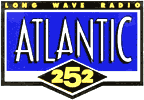 In the mid 1990's when Atlantic 252 was in its heyday, three other companies figured that they too could launch successful long-wave radio services for the UK. Of the three, two are still planning their launch nearly 10 years later and one has given up. A combination of political, financial and environmental obstacles have prevented any of the three stations from finally getting on-air and a question has to hang over the two who still have plans as to whether they will ever launch.
In the mid 1990's when Atlantic 252 was in its heyday, three other companies figured that they too could launch successful long-wave radio services for the UK. Of the three, two are still planning their launch nearly 10 years later and one has given up. A combination of political, financial and environmental obstacles have prevented any of the three stations from finally getting on-air and a question has to hang over the two who still have plans as to whether they will ever launch.The aforementioned IOMIB (whose other web-site can be found at longwaveradio.com) plan to launch a service tentively named 'MusicMann279' on 279kHz with a power of 500kW. Their transmitter site was originally planned to be on the mainland of the Isle of Mann, however due to local objections and despite planning to use a Cross-Field Antenna which is much smaller than a conventional antenna (and some would argue that its performance is in proportion to its dimensions), they now plan to build a platform in the Bahama Bank just off the island. There have been various rumours about a possible launch date for the service and plenty of speculation about what kind of service it might be, but so far no real evidence of any progress. There most recent rumours circulating are that the service will launch in the summer of 2006 at reduced power under the name of 'Caroline 279'.
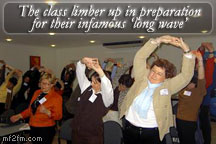 I somewhat doubt this latest rumour as there are a couple of aeronautical navigation beacons (non-directional beacons or NDB's), one near RAF Northolt on 277 kHz and one near RAF Lyneham on 282 kHz which are still in operation and in daily use. The interference to these beacons from the proposed Isle of Mann service would be so strong that they would have to change frequency and... they haven't!
I somewhat doubt this latest rumour as there are a couple of aeronautical navigation beacons (non-directional beacons or NDB's), one near RAF Northolt on 277 kHz and one near RAF Lyneham on 282 kHz which are still in operation and in daily use. The interference to these beacons from the proposed Isle of Mann service would be so strong that they would have to change frequency and... they haven't!The station which has now given up the ghost was known as variously 'Delta 171' or 'The Lounge' and was intended to provide an adult orientated middle-of-the-road, 'BBC Radio 2' style service, broadcasting out of the Netherlands. In the same way as in the Isle of Mann, there were local environmental objections to having a 500kW (half a MegaWatt!) transmitter on the doorstep so Delta was forced to consider a platform in the North Sea. This proved too expensive and the project collapsed in 2000 when the licence for the long wave frequency which had been awarded by the Dutch regulator expired and was not renewed.
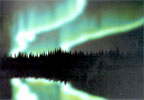 The final station which still claims to be planning a launch is 'Cruisin 216' which will carry Christian programming. Cruisin intends to operate out of southern Norway to put its signal into the UK, however the frequency they have of 216 kHz is shared with Radio Monte Carlo (RMC-Info) who use a powerful 1.4 MegaWatt transmitter from Roumoules in south western France. Cruisin's own web-site indicates that their signal in London will be approximately 13dB (20 times) stronger than that from RMC-Info, however the same article on their web-site also shows that this is insufficient for interference not to be a problem. The fact is that the RMC transmitter already puts in a good and listenable signal into London and most of the south eastern corner of England so the signal from Norway would have to be whopping to compete. In Scotland and the north of England they might stand a chance - of course being a religious station, there may be someone up there lending them a helping hand!
The final station which still claims to be planning a launch is 'Cruisin 216' which will carry Christian programming. Cruisin intends to operate out of southern Norway to put its signal into the UK, however the frequency they have of 216 kHz is shared with Radio Monte Carlo (RMC-Info) who use a powerful 1.4 MegaWatt transmitter from Roumoules in south western France. Cruisin's own web-site indicates that their signal in London will be approximately 13dB (20 times) stronger than that from RMC-Info, however the same article on their web-site also shows that this is insufficient for interference not to be a problem. The fact is that the RMC transmitter already puts in a good and listenable signal into London and most of the south eastern corner of England so the signal from Norway would have to be whopping to compete. In Scotland and the north of England they might stand a chance - of course being a religious station, there may be someone up there lending them a helping hand!Thursday 16 March, 2006, 13:44 - Radio Randomness
Wireless LAN's are fabulous things. You put a box next to your cable or ADSL modem with a little aerial on the back and your broadband internet connection miraculously becomes available all over your house to any device fitted with the appropriate wireless card. Or does it...?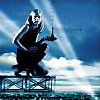 In some cases the position of the modem and wireless box are such that coverage does not extend to all points of your house. For example, most incoming telephone (and cable) connections tend to be on an external wall, which by default, is at one end of a property and not in the middle of it. And often they are at floor level, which is where all the modem/wireless equipment also ends up. Now although radio can at times seem magic, putting a wireless box on the floor at one end of your property probably means that upstairs at the other end, the signal is very weak. So what can be done to extend the coverage of wireless LANs?
In some cases the position of the modem and wireless box are such that coverage does not extend to all points of your house. For example, most incoming telephone (and cable) connections tend to be on an external wall, which by default, is at one end of a property and not in the middle of it. And often they are at floor level, which is where all the modem/wireless equipment also ends up. Now although radio can at times seem magic, putting a wireless box on the floor at one end of your property probably means that upstairs at the other end, the signal is very weak. So what can be done to extend the coverage of wireless LANs?The first, and easiest thing, is to put the wireless box in a more favourable position. Many can be wall mounted (though this still puts the device at one end of a building), but even raising the position from on the floor to head-height helps. If you have a phone socket or cable connection somewhere else in your house, i.e. in a lounge that might be more central, move the wireless box here and put it on a shelf so it's not at floor level. Putting the box centrally within a property helps even out the signal throughout the building.
 If neither of these are possible and the only place where the box can be located is next to the phone socket, is there anything else that can be done to make the signal stronger? The answer is a resounding YES. By far the easiest way to do this is to replace the antenna that comes with your wireless box for one with higher gain. Standard antennas have a gain of 2 dBi - this means that the effective radiated power (erp) of your wireless box is the same as the transmitter power, so if the transmitter is 10 milliWatts (mW), the radiated power will also be 10 mW. Replacing the aerial with one with higher gain increases the radiated power for the same transmitter power and has the added benefit that it improves reception by the wireless box too extending the overall range. Without going into the maths, to double the range of a transmitter, the radiated power has to go up by a factor of 4 (which can also be expressed as 6 dB). So an antenna with a gain of 8 dBi will double the range (or quadruple the coverage) of the system compared to one with 2 dBi gain.
If neither of these are possible and the only place where the box can be located is next to the phone socket, is there anything else that can be done to make the signal stronger? The answer is a resounding YES. By far the easiest way to do this is to replace the antenna that comes with your wireless box for one with higher gain. Standard antennas have a gain of 2 dBi - this means that the effective radiated power (erp) of your wireless box is the same as the transmitter power, so if the transmitter is 10 milliWatts (mW), the radiated power will also be 10 mW. Replacing the aerial with one with higher gain increases the radiated power for the same transmitter power and has the added benefit that it improves reception by the wireless box too extending the overall range. Without going into the maths, to double the range of a transmitter, the radiated power has to go up by a factor of 4 (which can also be expressed as 6 dB). So an antenna with a gain of 8 dBi will double the range (or quadruple the coverage) of the system compared to one with 2 dBi gain. And such antennas are available, and they're not expensive. Visit eBay and do a search for 9dBi and you'll find that for about GBP15 (including postage) there are lots of 9 dBi gain antennas available (remember to make sure that the connector on the bottom of the antenna is the right one for your wireless box - R-SMC are the most common, followed by R-TNC). Replace your standard antenna with one of these high-gainers (which are about 40cm long) and you should find that your coverage has gone up significantly.
And such antennas are available, and they're not expensive. Visit eBay and do a search for 9dBi and you'll find that for about GBP15 (including postage) there are lots of 9 dBi gain antennas available (remember to make sure that the connector on the bottom of the antenna is the right one for your wireless box - R-SMC are the most common, followed by R-TNC). Replace your standard antenna with one of these high-gainers (which are about 40cm long) and you should find that your coverage has gone up significantly.Is it legal to do this? Good question! In the UK, Ofcom allows powers up to 100 mW erp . The simple answer is 'it depends'. Most wireless LAN access points have a transmitter power of 100 mW already, so installing a high-gain antenna means the erp will exceed the UK limits. What are the chances of getting caught? That's a different matter...
Thursday 9 March, 2006, 15:24 - Pirate/Clandestine
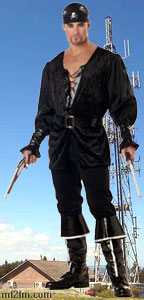 With all this talk of pirate radio, a question that often gets asked is, "But I've never heard a pirate station; where do I find one?". Yes, there are those who have yet to stumble across the skull and crossbones of the airwaves!
With all this talk of pirate radio, a question that often gets asked is, "But I've never heard a pirate station; where do I find one?". Yes, there are those who have yet to stumble across the skull and crossbones of the airwaves!The best place to look is on the FM dial of your radio. But with so many stations around, how do you know if the station you are listening to is a pirate or a legal station? There are a few clues which even the least experience listener should be able to fathom:
1. The signal is in mono. Most pirate stations broadcast in mono, however, this is not at all conclusive as many RSL stations do this too and further, some pirates broadcast in stereo.
2. There is no RDS. Including RDS can be complicated for some pirates so they choose not to use it. This is still not totally conculsive though, as some RSL stations have no RDS either.
 3. The RDS is 'scrolling' (i.e. it is changing to display a message - as shown here on the right). Legal stations in Europe are obliged by the European Commission to use a static name on their RDS display to make sure drivers aren't distracted. Pirates, however, can change the name of the station to display messages on RDS equipped radios. A few legal stations (not in the UK though) do scroll or rotate the message on the RDS display so this too isn't totally conclusive, however reading the message might give a good indication. If it's advertising a party at a local night club then chances are you're listening to a local pirate!
3. The RDS is 'scrolling' (i.e. it is changing to display a message - as shown here on the right). Legal stations in Europe are obliged by the European Commission to use a static name on their RDS display to make sure drivers aren't distracted. Pirates, however, can change the name of the station to display messages on RDS equipped radios. A few legal stations (not in the UK though) do scroll or rotate the message on the RDS display so this too isn't totally conclusive, however reading the message might give a good indication. If it's advertising a party at a local night club then chances are you're listening to a local pirate!4. The presenter doesn't have a middle-class accent! This is especially true on FM stations in the UK, where legal stations try to recruit presenters with unoffensive voices that won't turn listeners off. As pirate stations are usually there to promote the music or club nights, whether the presenter can pronounce 'Douglas St.John Farquhar' correctly really doesn't matter!
 5. The phone number being given out to contact the station is a mobile number (all mobile numbers begin with '07' in the UK). How many legal stations do you know who would, or would need to, use a mobile number for calls to the studio? Further, if you're requested to leave 'missed calls', i.e. to phone the number but not let it answer, you're almost certainly onto a pirate. This is a way to show you are listening without having to spend a single penny on phone calls - quite smart really!
5. The phone number being given out to contact the station is a mobile number (all mobile numbers begin with '07' in the UK). How many legal stations do you know who would, or would need to, use a mobile number for calls to the studio? Further, if you're requested to leave 'missed calls', i.e. to phone the number but not let it answer, you're almost certainly onto a pirate. This is a way to show you are listening without having to spend a single penny on phone calls - quite smart really!Of course there are other clues, such as the frequency being used (if it's in the middle of the band used for national BBC stations but isn't a BBC station then it's most likely a pirate), but the ones above don't require any technical knowledge. You're more likely to find a pirate station on FM if you live in, or near, a major city than if you live out in the countryside, but you might be surprised.
Another place to find pirates is in the radio no man's land just at the edges of the normal short-wave broadcast bands, especially the lower frequency bands. Why the lower frequency bands in particular - they're better for broadcasting to nearby areas and tend to be more reliable throughout the daily propagation cycle. Good places to listen for pirate short-wave stations are:
* 3800-3950 and 4000-4100 kHz, either side of the 75m broadcast band
* 5750-5900 and 6200-6400 kHz, either side of the 49m broadcast band
* 6800-7000 and 7350-7600 kHz, either side of the 41m broadcast band (avoiding the 40m amateur band too)
* 9300-9400 and 9900-10000 kHz, either side of the 31m broadcast band
And so on either side of the other short wave broadcast bands too... Though the use of frequencies above about 10 MHz is rarer, there are examples such as Alfa Lima on 15070 (± a bit) and 21900 (± a bit) kHz and WR International on 12256 kHz.
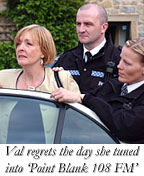 One final place you might come across a pirate station is on the medium wave (MW) band. Most stations prefer FM for local broadcasting as the antennas are smaller and the equipment easier to get hold of, but a few stations do use MW. Radio Free London used to put out a good signal across London on 819 kHz and there are quite a few stations (particularly in continental Europe) who inhabit the no man's land just off the end of the MW band between 1611 and 1640 kHz.
One final place you might come across a pirate station is on the medium wave (MW) band. Most stations prefer FM for local broadcasting as the antennas are smaller and the equipment easier to get hold of, but a few stations do use MW. Radio Free London used to put out a good signal across London on 819 kHz and there are quite a few stations (particularly in continental Europe) who inhabit the no man's land just off the end of the MW band between 1611 and 1640 kHz.Of course I couldn't possibly condone any activity which would lead you to listen to a pirate and thus break the law in doing so. But at least now you might be able to stop yourself from committing this heinous crime before you get caught!


